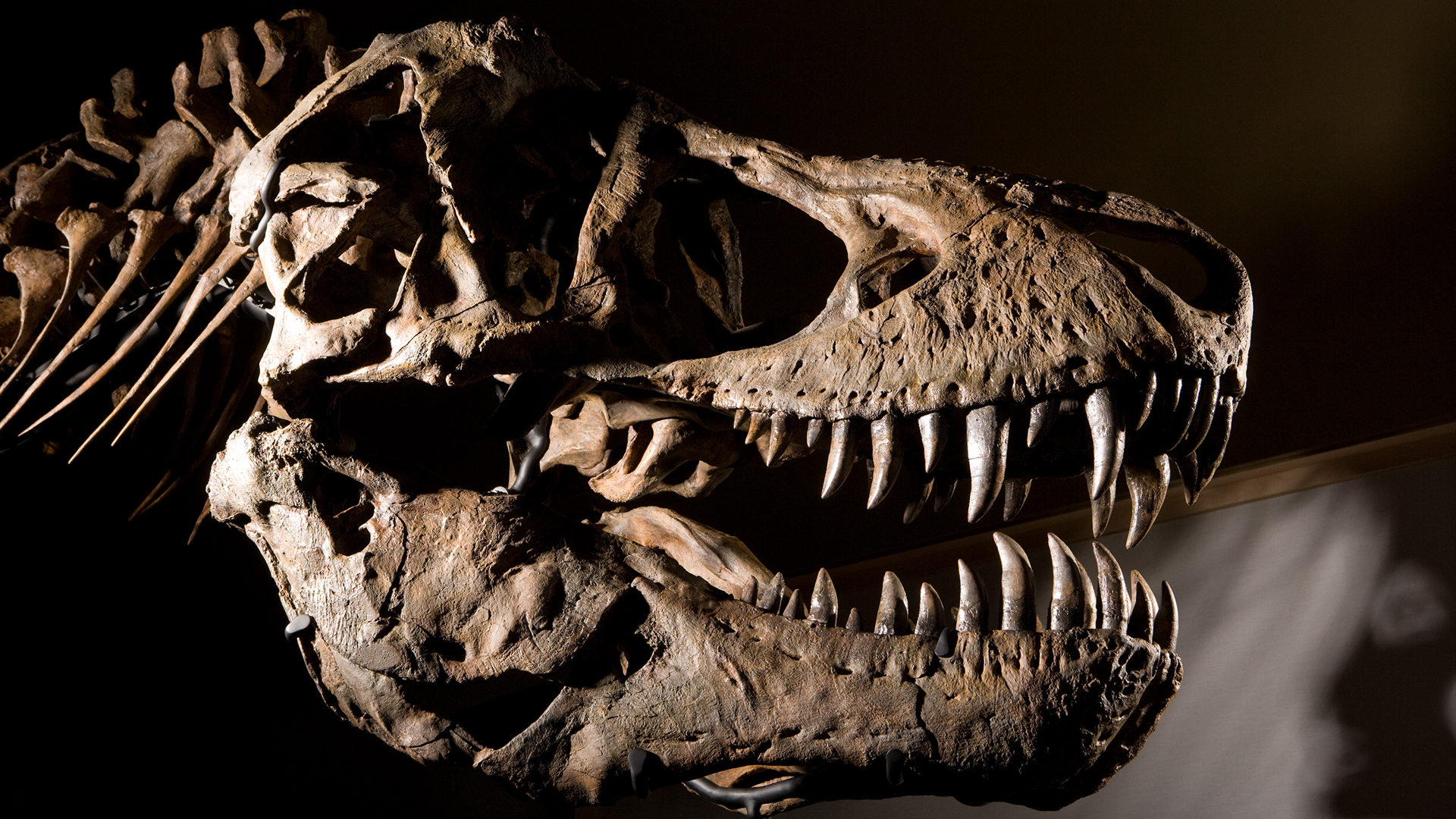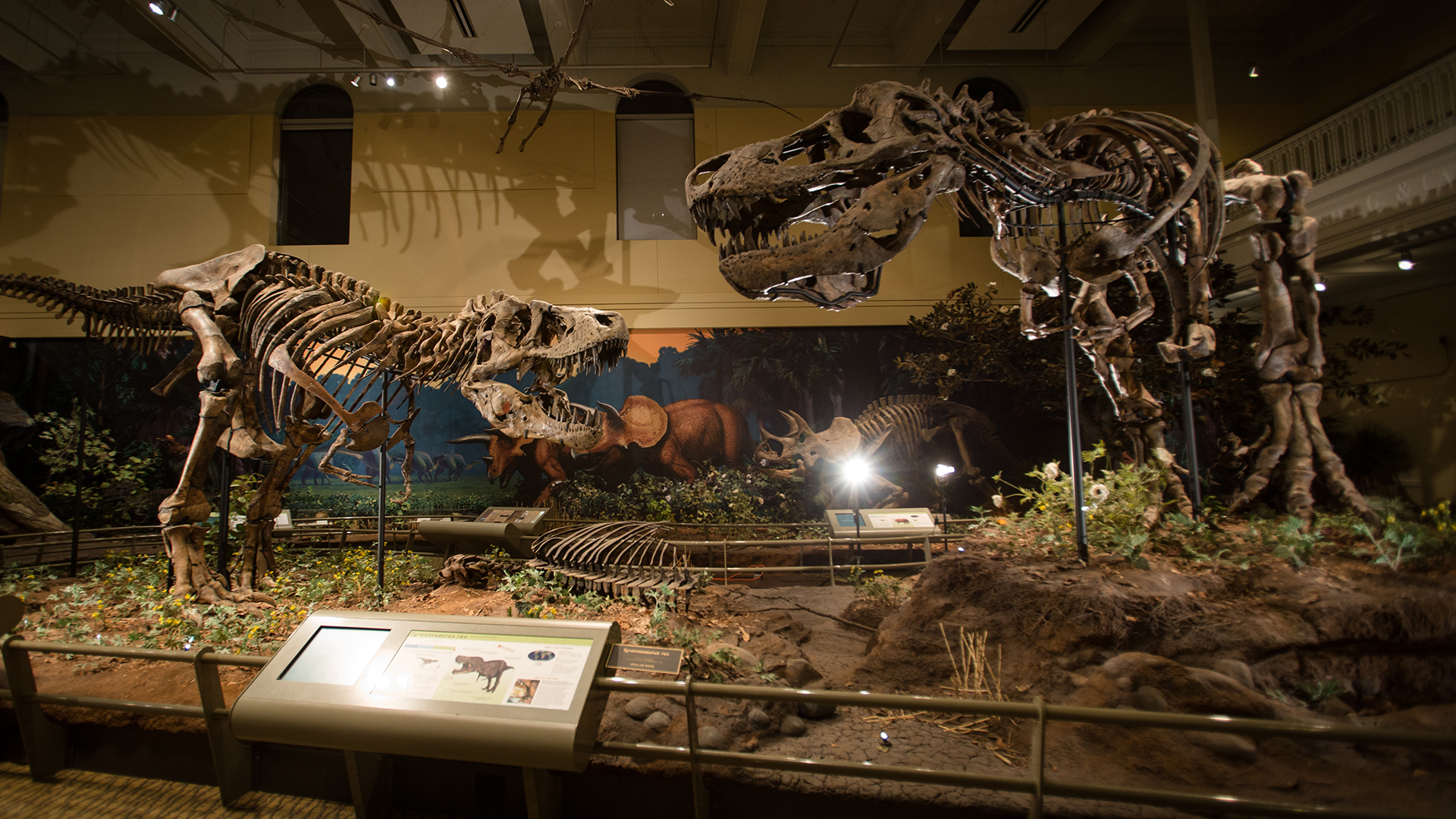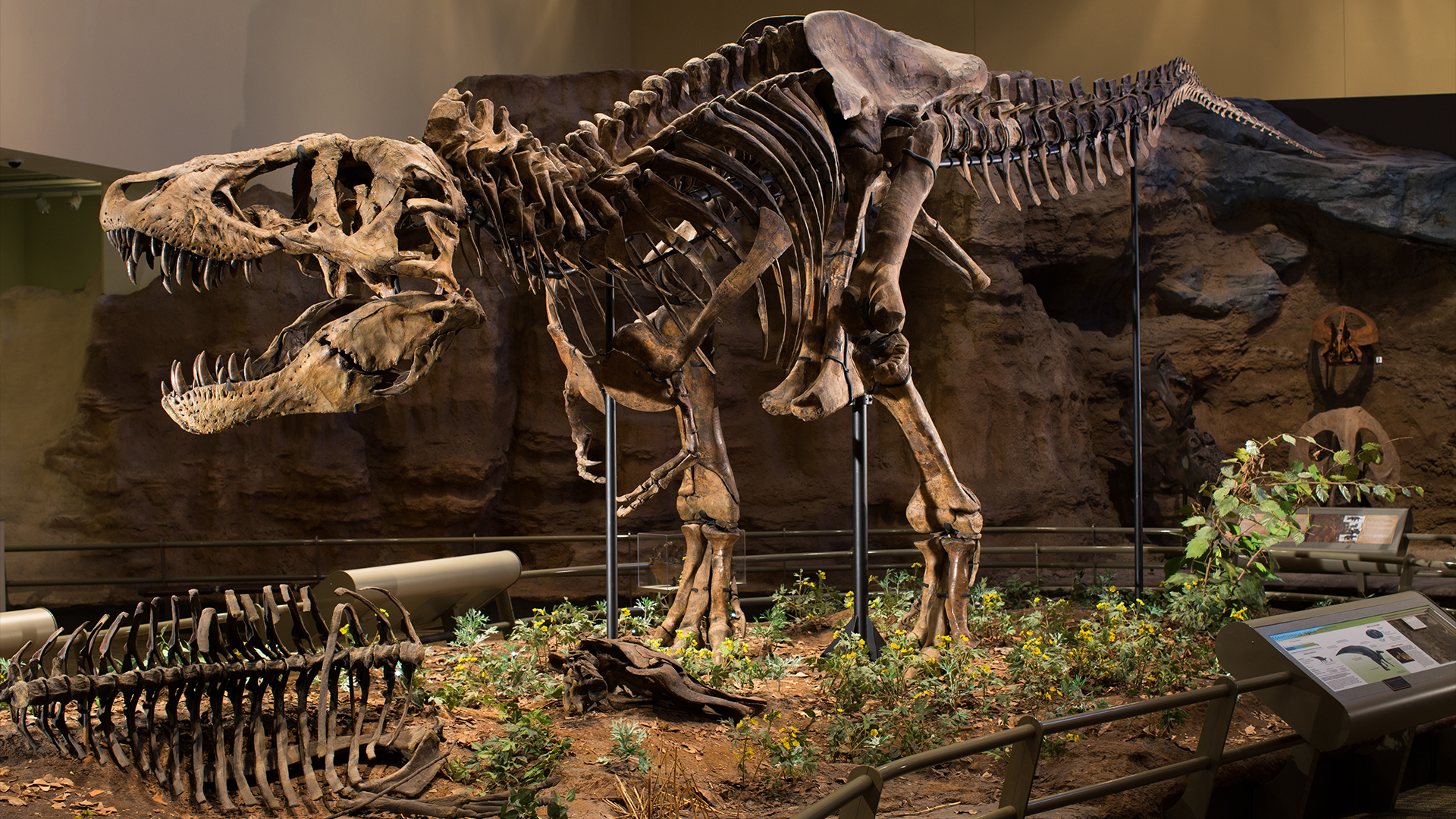Tyrannosaurus rex: Facts and photos of the dinosaur king
Tyrannosaurus rex was one of the largest carnivorous dinosaurs that ever lived.

The mighty Tyrannosaurus rex is arguably the most iconic dinosaur that ever lived. Ever since the discovery of its fossils more than a century ago, T. rex has fascinated people of all ages and walks of life, and today it plays a starring role in studies, museums and popular culture, including the "Jurassic Park" movies.
Tyrannosaurus means "tyrant lizard" in Greek, while rex is Latin for "king," making it the "king of the tyrant lizards." Due to its fame, T. rex will continue to reign in the spotlight as more of its fossils are discovered and analyzed.
When did T. rex live?
T. rex lived between 67 million and 66 million years ago, at the end of the Cretaceous period (145 million to 66 million years ago).
However, there's a bit of a "wrinkle," according to Thomas Carr, T. rex expert and associate professor of biology at Carthage College in Wisconsin. That's because there's a gap in the fossil record from 69 million to 67 million years ago in what is now the Western U.S. and Canada, where T. rex fossils are typically found.
Up until 69 million years ago, many of the dinosaurs in the Hell Creek Formation, which includes parts of present day Montana, North Dakota, South Dakota and Wyoming, were small, or no longer than 30 feet (9 meters) long, Carr told Live Science. After the "blackout," fossils from 67 million years ago show that the dinosaurs were larger and completely different to before. It's also the first time that T. rex remains appear.
So, where did T. rex come from?
"We know there was a sea level drawdown around 68 million years ago. That would have connected North America to Asia through [the land bridge] Beringia," Carr said. "We had Asian dinosaurs coming in. So T. rex would have been part of that invasive fauna."
Get the world’s most fascinating discoveries delivered straight to your inbox.
However, it's unclear exactly when T. rex's reign began. It couldn't have been before sea levels dropped 68 million years ago. While it's unknown if T. rex existed from either 68 million or 67 million years ago, one thing is certain: The tyrant king went extinct, along with the other non-avian dinosaurs, 66 million years ago when an asteroid slammed into Earth.
How big was T. rex?
T. rex is one of the largest carnivorous dinosaurs on record. Sue, the most complete T. rex specimen with 90% of its bones accounted for and whose remains reside at the Field Museum of Natural History in Chicago, was likely about 41 feet (12 m) long and about 12.5 feet (3.8 m) tall at the hips, Carr said — although this is an estimate, as a complete T. rex tail has never been found. T. rex adults weighed between an average of 15,266 and 23,037 pounds (6,925 and 10,450 kilograms), according to different studies.
The largest T. rex on record is the heavyweight champ known as Scotty, but "it's really marginal," Carr said. "We're talking differences on a scale of inches."
Analysis of the Scotty specimen suggests T. rex had a maximum mass of about 19,555 pounds (8,870 kg), although it's possible that the tyrant king weighed up to 33,000 pounds (15,000 kg), according to research presented at the Society of Vertebrate Paleontology's (SVP) annual meeting in 2022.
T. rex wasn't the largest carnivorous dinosaur, however. That honor goes to Spinosaurus, which was probably a few meters longer, Carr said.
When and where was T. rex discovered?
Barnum Brown, a fossil hunter working for the American Museum of Natural History (AMNH) in New York City, discovered the first documented T. rex fossils in Hell Creek, Montana in 1902. Brown was working alongside Richard Lull, a paleontologist at Yale University. "The story goes that they set up camp and they found the fossil very shortly afterwards, which just makes me crazy with envy," Carr said.
The bones were sent to the AMNH, where paleontologist Henry Fairfield Osborn analyzed them. This T. rex skeleton, which is about 10% complete, became the holotype, or the specimen used to scientifically name and describe the newfound species, according to the 1905 article that Osborn published in the Bulletin of the American Museum of Natural History. This T. rex is now at the Carnegie Museum of Natural History in Pittsburgh, where it was moved after fears that New York City might be bombed during World War II.
However, this specimen wasn't the first T. rex fossil ever unearthed. In 1892, paleontologist Edward Cope published a report on two partial vertebrae from South Dakota that he thought came from a ceratopsid, or horned dinosaur, which he named Manospondylus gigas. Over a century later, after more identifiable bones were found at the same spot, these vertebrae were eventually assigned to T. rex, Carr said. Usually, the first proposed scientific name takes precedence, meaning we'd all be calling the tyrant king Manospondylus gigas today, were it not for the fact that the vertebrae weren't detailed enough to identify the species at the time, Carr said. So, the name T. rex stuck.
One more naming blunder nearly plagued T. rex. In 1900 — before the big 1902 discovery — Barnum found the remains of a carnivorous dinosaur and sent its fossils to Osborn. Osborn included this specimen in the landmark 1905 report, in which he named and described T. rex first and this dinosaur — Dynamosaurus imperiosus, the imperial powerful lizard — a few pages later.
After publication, Osborn realized his mistake: D. imperiosus was the same as T. rex. But because Osborn named T. rex first by a matter of pages, that name remained the official one.
"[Osborn] had a genius for really good names," Carr said. "I think Tyrannosaurus rex and Dynamosaurus imperiosus are winners right out of the gate. I'm glad T. rex was first, though."
What did T. rex eat?
Coprolite, or fossilized poop, evidence shows that T. rex ate ornithischian, or bird-hipped, dinosaurs, like the duck-billed Edmontosaurus, a 1998 study in the journal Nature found. Researchers have also discovered T. rex bite marks in the bones of other duck-billed dinosaurs and Triceratops bones, according to a 1996 study in the Journal of Vertebrate Paleontology. "So we know that the diet included the largest dinosaurs on the landscape," Carr said.
T. rex hatchlings, measuring about 3 feet (1 m) long, likely guzzled down small prey, such as mammals (during the dinosaur age, mammals were no larger than badgers), snakes and frogs, Carr said. As they grew larger, their meals likely transitioned from lizards and baby crocodilians to young dinosaurs. "The size of the prey will increase with the predator," Carr said.
Where did T. rex live?
According to the fossil record, T. rex lived in western North America, from as far north as modern-day Saskatchewan and Alberta, Canada, to as far south as what is now Texas.
During the late Cretaceous, when T. rex was alive, this swath of land was part of an island continent known as Laramidia, which spanned from what is now Alaska to Mexico. It's possible that T. rex's stomping grounds included more parts of Laramidia; however, due to erosion, scientists haven't found T. rex fossils in places such as Alaska and Mexico, Carr said.
Where did T. rex come from?
The closest relative of T. rex, anatomically speaking, is Tyrannosaurus bataar (also known as Tarbosaurus), which was unearthed in modern-day Mongolia. In a 2016 study, Carr and Steve Brusatte, a paleontologist at the University of Edinburgh in Scotland, examined the bones of 28 different tyrannosaur species and created a family tree, documenting when and where each species existed.
T. rex is also closely related to Zhuchengtyrannus, another tyrannosaur from what is now Asia, they found. "Ancestrally, it looks like T. rex had its roots in Asia," Carr said. "Ergo, its presence in North America and Laramidia is an example of something called dispersal, where an ancestral stock will get up and move from one place to another."
The land bridge connecting Asia to North America temporarily surfaced around 68 million years ago, so that's likely when a population of these giant Asian tyrannosaurs tromped over, Carr noted.
T. rex's life stages
Researchers think that T. rex had two main life stages. During the first stage, or up until ages 13 to 14, these dinosaurs were "very sleek, very graceful looking animals," almost like a Doberman pinscher, Carr said. Then, during the second stage, these dinosaur kings rapidly transformed. "The skull became deep, the teeth thickened, it became very chunky and almost pit bull like," Carr said. "It's a more powerful build that just took a couple years."
T. rex likely became sexually mature at around age 14. One specimen — the only known female T. rex on record, which died at around age 15 — was found to have medullary bone, a bone tissue that has extra calcium deposits in it for egg-laying females, according to a 2005 study in the journal Science. This T. rex was likely pregnant when she died.
Sue is the oldest known individual and may have lived to age 33, according to a 2020 study in the journal Proceedings of the Royal Society B.
T. rex behavior
Dinosaurs are archosaurs, a large group of animals whose surviving members include birds and crocodilians. Both birds and crocodiles tend to be gregarious, so it's possible that the common ancestor of archosaurs was also social, Carr said.
T. rex left some clues suggesting that it might have been gregarious. For instance, in northeastern British Columbia, Canada, researchers studied three parallel tyrannosaurid trackways, which indicated that the three dinosaurs had walked near each other while traveling in the same direction, according to a 2014 study published in the journal PLOS One. However, it's unclear if the trackways were made at the same or different times, so it's possible that these tyrannosaurs weren't walking together.
Another clue is the ratio of brain size to body size. Like smart modern reptiles, such as crocodiles and turtles, tyrannosaurs had a big brain compared to their body size. "My bias is that tyrannosaurs were probably a lot like alligators and crocodiles in their behavior, so we shouldn't expect them to be like mammals at all — they're way too dumb for that. But for a reptile, they're pretty smart," Carr said. "I'm sure mommy T. rex would have guarded the nest, maybe guarded hatchlings and that would have faded out in a few weeks or few months, but they're not mammal-like creatures at all."
Meanwhile, analysis of the T. rex braincase (where the brain sat) has revealed large olfactory bulbs, so these dinosaurs likely had a good sense of smell, Carr said. They also had keen eyesight. (It's "complete fiction" that T. rex couldn't see prey that was standing still, a myth the 1993 movie "Jurassic Park" started, Carr said.)
Tyrannosaurs may have bitten each other's faces in brawls that weren't meant to kill but rather determine the winner for "prizes," such as territory, mates or higher status, a 2021 study in the journal Paleobiology found. However, Carr suspects that the many facial injuries found on tyrannosaur skulls were the result of bites from feeding frenzies, when tyrannosaurs likely got too close and snipped at each other while feasting on carcasses.
"At the end of the day, the bites on the faces are evidence that tyrannosaurs were gregarious," Carr said. "You can't do that at a distance."
Why did T. rex have short arms?
One of T. rex's most iconic features is its puny arms. Paleontologists have suggested various uses for these ridiculously short appendages, including that T. rex used its arms for mating, holding or stabbing prey or even for tipping over Triceratops.
T. rex's teeth and bite force
T. rex's blade-like teeth were serrated and sharp, a deadly combination for its prey. Young T. rex individuals had lots of narrow teeth; but as these carnivores grew older, their tooth count decreased as these teeth grew larger and more robust, Carr said. To put a number on it, juveniles could have up to 74 teeth, while adults had up to 54 huge chompers, he said.
T. rex was constantly losing and growing new teeth, so it's not uncommon to find the tyrant's teeth at fossil sites in western North America.
According to a 2017 paper, the T. rex Sue had a bite force of up to 34,520 newtons. When looking at the pressure exerted by a single tooth, the 2017 paper found that T. rex generated 2,974 megapascals (431,342 pounds per square inch), which could crunch bone.
The longest T. rex crown (the part of the tooth above the gum line) is 4.6 inches (11.7 centimeters).
Was T. rex fast or slow?
T. rex was fierce, but it wasn't fast. A 2021 study that factored in the motion of the dinosaur's swinging tail found that T. rex's preferred walking speed was just under 3 mph (5 km/h), which is slower than previously calculated walking speeds of between 4.5 and 6.7 mph (7.2 and 10.8 km/h), or about as fast as a typical human runner.
However, the 2021 study accounted only for up and down movements of the tail, not side to side, John Hutchinson, a professor of evolutionary biomechanics at The Royal Veterinary College in the U.K., who has studied T. rex speeds but was not involved in the study, previously told Live Science.
The tyrant king could possibly run — meaning that both its feet left the ground — and may have reached speeds of between 10 to 25 mph (16 to 40 km/h), Hutchinson said. However, more research is needed to support this.
Did T. rex have feathers?
There's no evidence that T. rex sported feathers. Other theropods — a group of bipedal, mostly meat-eating dinosaurs — have left fossil remains of feathers, as have some ornithopods and even the early tyrannosauroids Yutyrannus and Dilong. But fossils don't show any feathers on T. rex.
Rather, well-preserved T. rex remains — including of their neck, torso, tail, legs and feet — indicate that they were scaley. "They're fairly fine scales, mostly," Carr said. "They would have looked like they're wearing velvet, the scales were quite tiny."
What did T. rex sound like?
It's impossible to know what T. rex's roar sounded like, but we do have hints. For instance, an analysis of its inner ear structure suggests that T. rex could have heard low-frequency noises, Carr said. This suggests two things: that its prey, like duck-billed dinosaurs and horned dinosaurs, made low-frequency sounds, or that T. rex made low-frequency sounds. Or maybe both are correct.
Why did T. rex go extinct?
About 66 million years ago, a 10-mile-wide (6.4 km) asteroid slammed into Earth. Any animal that survived the asteroid's initial shockwave would have faced ecological collapse, including fires destroying habitats, acid rain and nuclear winter after dust and debris smashed into the atmosphere, blocking the sun (although a 2023 study disputes the long nuclear winter aspect). "The animals might have experienced hypothermia as well, with the sun being blocked out by the clouds," Carr said. "So it would have been a very dismal expiration."
Additional resources
Watch a video from the Natural History Museum of London on why T. rex had such tiny arms. Read a piece from the University of California, Berkeley to learn if T. rex was a predator, scavenger or both. Read about the Nanotyrannus controversy — is this smaller, sleeker dinosaur a young T. Rex or a different species entirely?
Editor's note: This article was originally published on Oct. 17, 2017 and rewritten on April 1, 2024.

Laura is the managing editor at Live Science. She also runs the archaeology section and the Life's Little Mysteries series. Her work has appeared in The New York Times, Scholastic, Popular Science and Spectrum, a site on autism research. She has won multiple awards from the Society of Professional Journalists and the Washington Newspaper Publishers Association for her reporting at a weekly newspaper near Seattle. Laura holds a bachelor's degree in English literature and psychology from Washington University in St. Louis and a master's degree in science writing from NYU.









